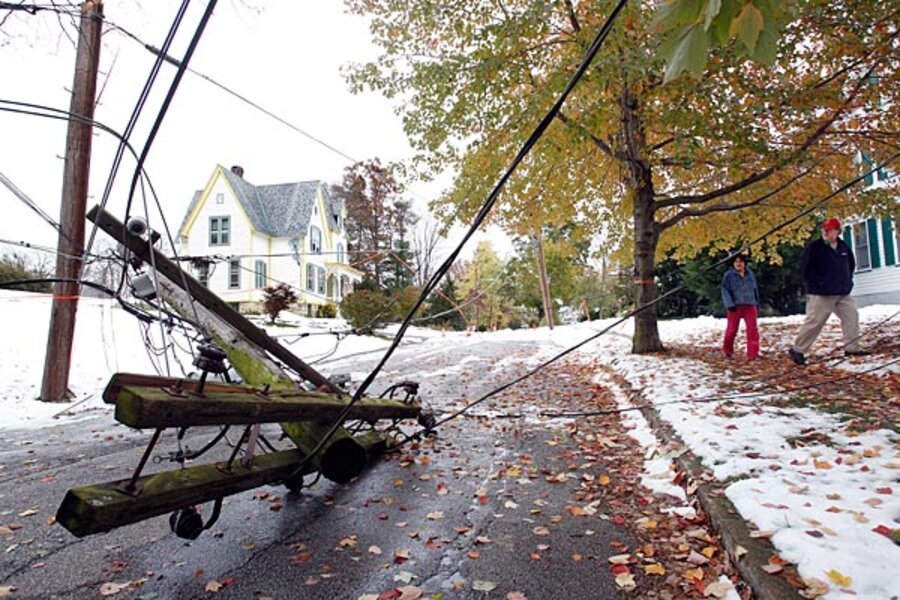After the snowstorm: Power outages mean no heat, no trick-or-treating
Loading...
| New York
If this past Saturday’s snowstorm illustrates anything, it is the relatively fragile nature of the electric power grid and America’s reliance on it.
Until hard-pressed utility crews get the lines restrung, many residents from North Carolina to Maine are living in homes that are barely 50 degrees, and in some cases, they’re unable to heat food. School systems are closed because, among other reasons, it’s not safe for children to walk on sidewalks that may still have live power lines on them. And many businesses aren’t open because they're still in the midst of power outages.
“Electricity is the most fundamental of utilities. Most everything depends on electric power,” says Kathleen Tierney, director of the Natural Hazards Center at the University of Colorado at Boulder. “This has many of the earmarks of a disaster.”
In some states, governors are warning residents they may have to grin and bear it for days or even another week since the heavy snow did extensive damage to the electric grid. For example, in Connecticut and Pennsylvania, the snow knocked out some of the lines that get power from the generating plants to substations, where it then goes into a local distribution network. Connecticut Gov. Dannel Malloy (D) has asked President Obama to declare the state a federal disaster area, which would help with cleanup and recovery costs.
“Connecticut is now in the very first stages of recovering from a storm of a magnitude and at a time of year that we have never experienced before,” said Governor Malloy in his request for federal aid.
In Massachusetts, Gov. Deval Patrick (D) says he intends to ask for the state to be declared a disaster area.
In many areas, grocery stores can’t operate checkout counters, some people can’t get money from ATMs, and gasoline stations can’t pump fuel. Restaurants are jammed as people without electricity search for a hot meal.
“These things turn out to be very expensive,” Ms. Tierney says. “People can’t go to work. You have a business interruption situation here.”
Examples on a local basis illustrate the severity of the storm. New Canaan, Conn., has hundreds of downed power lines, the town’s Office of Emergency Management estimates. Residents are being encouraged to report them on New Canaan’s Facebook page.
In Bethlehem, Pa., Michael Alkhal, director of public works, says his community resembles a war zone. “There are downed wires everywhere,” he says. “This is a lot worse than hurricane Irene, at least in terms of power outages and trees.”
As of Sunday evening, Mr. Alkhal says, the Lehigh Valley had 78,000 people without power. “Unfortunately, there are still a lot of outages,” he says.
For millions of children in the region, the storm has also resulted in a big disappointment: Halloween trick-or-treating has been canceled or postponed, since officials don’t want kids walking on the streets where there might be live electric wires.
Sleepy Hollow, N.Y., home of Washington Irving’s headless horseman, won’t have its annual hayride, a popular event. “There are continuing safety concerns including broken limbs and branches that are still hanging from trees along the route,” says Mayor Ken Wray in a statement.
Utilities say they are working as hard as they can, and many have brought in outside contractors to help with the work. On its website, Con Edison, which supplies electricity for some parts of Westchester County, N.Y., as well as New York City, said it had added 1,000 workers on Monday.
One key challenge for the utilities is the wide scope of the snowfall, says Tierney. “Because the problem is regional in scale, it is very challenging to bring workers in,” she says. “It comes down to what you do to prioritize and how to triage this thing and get the resources to where they are needed.”
In New Canaan, for instance, the Office of Emergency Management told residents that priority would go to an area that had 1,000 homes without electricity.
Many individuals have tried to cope the best they can. In Tarrytown, N.Y., Rob and Melinda DeRocker are encouraging their Labrador retriever to sit on their laps for warmth. “The Lab is loving it,” Mr. DeRocker says.
He and his wife eat dinner by candlelight and have a fire going in their fireplace – even though he is aware that it actually results in a loss of heat.
“If there is any message here, it is that it’s time for a generator,” says DeRocker.
But safety organizations warn people to make sure that any generators are installed by professional electricians. There have been reports of near tragedies in Connecticut and Massachusetts from generators that were improperly used indoors, the US Consumer Product Safety Commission said on Monday. This can result in the release of deadly carbon monoxide.
In addition, Connecticut Light & Power has reminded homeowners that if a generator is installed incorrectly, it can result in a flow-back of power into the lines, which could injure workers trying to get power up and running.


